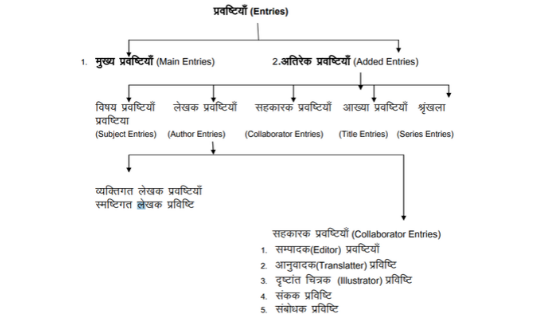What is an Entry | Describe the different types of Entries | Main Entry and Added Entry.
What is Entry in Library Science
The reader wants to explore any book from different dimensions. If someone remembers the author's name, he would like to search with the author; If someone remembers the legend, he would like to search through the legend; A subject wants to search with access.
Thus,
keeping in mind the different approaches of the readers, various entries of a single book is made and those entries are arranged in a catalog cabinet in
ascending order provided that the list is in sheet format.
 |
| Entry & Type of Entries |
Types of Entries
Generally,
there are two types of entry, it can be understood as follows:
 |
| Type of Entries |
Parts of Main Entry A main entry is made for
each book. The main entry is divided into the following five parts -
1. Heading
2.
Description
3. Tracing
4. Call No.
5. Accession
No.
1. Heading -
The title of the main entry is the most important part. The title either gives
the name of the author of the book or gives the title. It starts with the first
margin on the mainline.
2.
Description - Description is the largest part of the main entry. It has the
following eight fields
- Statement of account
- Edition
- A specific description of the type of document or publication
- Publication, distribution, etc.
- Alphabetical description
- Granthamala
- Comment
- Standard Number and Availability Terms.
3. Tracing -
Under this, the title of the redundant entries to be made in addition to the
main entry is given in a separate paragraph and it is written at the end.
4. Call
Number - Under this, there is a class number and a text number. The square
number starts writing from the leftmost edge of the listing sheet on the line
just above the mainline and it moves straight forward on the same line. The
text number is written from the leftmost edge of the listing sheet on the
mainline. Since the number is small, it ends before the title. The index is
written with a pencil.
5. Accession
Number - It is written on the fourth lower line, counting the mainline. Added
Entry - In the lexicographic list, which is constructed according to the rules
of AACR 2, the unit sheet method for redundant entries is adopted.
According to
this method, as many copies of the main entry are prepared as exact entries are
to be made. The title of the redundancy entry on each of those copies is
written on the first line from the second margin. If the first line is not
working then the second line is used with the third imaginary margin.
1. Subject
Added Entry - Subject redundancy entry is made first in redundancy entries.
This requires a subject title.
Texts like
'Sears List of Subject Headings', 'Library of Congress Subject Headings', etc.
are used for standard subject titles. All the subject titles are described in
sequential order in this book.
2. Author
Subject Added Entry - Author Subject Added Entry needs to be created only if
there are books written by more than one author.
For example, if there are
texts written by two authors and neither of them is the head writer, then the first author is given in the title of the main entry and the second author is
made under the author's redundancy.
If there is a book written by three authors
and none of them is the lead author, then the first author is given the title
of the main entry and two author redundancy entries are made separately for the
remaining two authors.
In the case of works with more than three authors, we
first, see if there is a principal writer or if the principal is not the author,
then only the author is made redundant from the first author.
3. Title
Added Entry - The need to create a title redundancy entry occurs when the main
entry is made under the author. If the main entry is made under the number then
it is not necessary to create a redundancy entry.
Since the
main entry with the first-level description does not mention co-operatives and
texts, there is no need to create redundant entries from these approaches.
To Know More About Library Science Click on the Link Given Below
| ||
1. Library and Society
| ||
2. Library Management
| ||
3. Library Cataloging
| ||
4. Library Classification
| ||
5. Information Source
| ||
6. MCQs on Library Science
| ||
8. Jobs in Library Science
| ||
Join Library Science Group for Latest Updates
| ||

Post a Comment